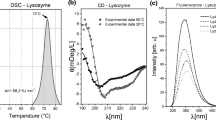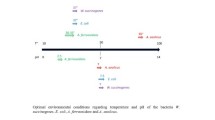Abstract
The conformational state of sperm whale apomyoglobin (apoMb) was studied at neutral pH in the presence of negatively charged vesicles using near and far UV circular dichroism, tryptophan fluorescence, differential scanning microcalorimetry, and fast performance liquid chromatography. Under these conditions, the apoMb structure undergoes transition from its native to an intermediate state. In this state the protein loses its rigid native structure but retains its secondary structure. However, the environment of tryptophan residues remains rather hydrophobic. This intermediate state of apoMb shows properties similar to those of its molten globule state in solution. It is shown that apoMb can bind to negatively charged phospholipid vesicles even at neutral pH. A possible functional role of this intermediate state is discussed.
Similar content being viewed by others
REFERENCES
Light III W.R., Olson J.S. 1990. Transmembrane movement of heme. J. Biol. Chem. 265, 15623–15631.
Cannon J.B., Kuo F.S., Pasternack R.F., Wong N.M., Muller-Eberhard U. 1984. Kinetics of the interaction of hemin liposomes with heme binding proteins. Biochemistry. 23, 3715–3721.
Antonini E., Brunori M. 1971. Hemoglobin and myoglobin in their reactions with ligands. Frontiers of Biology. Eds. Neuberger A., Tatum E.L. Amsterdam-London: North-Holland Publishing Company. 21, 436 p.
Griko Yu.V., Privalov P.L., Venyaminov S.Yu., Kutyshenko V. P. 1988. Thermodynamic study of the apomyoglobin structure. J. Mol. Biol. 202, 127–138.
Hughson F.M., Wright P.E., Baldwin R.L. 1990. Structural characterization of a partly folded apomyoglobin intermediate. Science. 249, 1544–1548.
Jennings P., Wright P.E. 1993. Formation of a molten globule intermediate early in the kinetic folding pathway of apomyoglobin. Science. 262, 892–896.
Nishii I., Kataoka M., Goto Y. 1995. Thermodynamic stability of the molten globule states of apomyoglobin. J. Mol. Biol. 250, 223–238.
Bismuto E., Colonna G., Savy F., Irace G. 1985. Myoglobin structure and regulation of solvent accessibility of heme pocket. Int. J. Peptide Protein Res. 26, 195–207.
Privalov P.L., Griko Yu.V., Venyaminov S.Yu., Kutyshenko V.P. 1986. Cold denaturation of myoglobin. J. Mol. Biol. 190, 487–498.
Bychkova V.E., Ptitsyn O.B. 1993. The molten globule in vitro and in vivo. Chemtracts-Biochem. and Mol. Biol. 4, 133–163.
Ptitsyn O.B., Bychkova V.E., Uversky V.N. 1995. Kinetic and equilibrium folding intermediates. Phil. Trans. Royal Soc. 348, 35–41.
Endo T., Eilers M., Schatz G. 1989. Binding of a tightly folded artificial mitochondrial precursor protein to the mitochondrial outer membrane involves a lipid-mediated conformational change. J. Biol. Chem. 264, 2951–2956.
de Kruijff B. 1994. Anionic phospholipids and protein translocation. FEBS Lett. 346, 78–82.
Ahn T., Kim J.-S., Lee B.-C., Yun C.-H. 2001. Effects of lipids on the interaction of SecA with model membranes. Arch. Biochem. Biophys. 359, 14–20.
Thorolfsson M., Doskeland A.P., Muga A., Martinez A. 2002. The binding of tyrosine hydroxylase to negatively charged lipid bilayers involves the N-terminal region of the enzyme. FEBS Lett. 519, 221–226.
Chao H., Martin G.G., Russell W.K., Waghela S.D., Russell D.H., Schroeder F., Kier A.B. 2002. Membrane charge and curvature determine interaction with acyl-CoA binding protein (ACBP) and fatty acyl-CoA targeting. Biochemistry. 41, 10540–10553.
Weinreb G.E., Mukhopadhyay K., Majumder R., Lentz B.R. 2003. Cooperative roles of factor V(a) and phosphatidylserine-containing membranes as cofactors in prothrombin activation. J. Biol. Chem. 278, 5679–5684.
Kim J., Kim H. 1986. Fusion of phospholipid vesicles induced by alpha-lactalbumin at acidic pH. Biochemistry. 25, 7867–7874.
Banuelos S., Muga A. 1995. Binding of molten globule-like conformations to lipid bilayers. Structure of native and partially folded alpha-lactalbumin bound to model membranes. J. Biol. Chem. 270, 29910–29915.
Shin I., Silman I., Weiner, L. 1996. Interaction of partially unfolded forms of Torpedo acetylcholinesterase with liposomes. Protein Sci. 5, 42–51.
Shin I., Silman I., Bon C., Weiner L. 1998. Liposome-catalyzed unfolding of acetylcholinesterase from Bungarus fasciatus. Biochemistry. 37, 4310–4316.
Silversmith R.E., Nelsestuen G.L. 1986. Assembly of the membrane attack complex of complement on small unilamellar phospholipid vesicles. Biochemistry. 25, 7717–7725.
Lee J.W., Kim H. 1988. Apomyoglobin forms a micellar complex with phospholipid at low pH. FEBS Lett. 241, 181–184.
van der Goot F.G., Gonzalez-Manas J.M., Lakey J.H., Pattus F. 1991. A “molten-globule” membrane-insertion intermediate of the pore-forming domain of colicin A. Nature. 354, 408–410.
Mel S.F., Stroud R.M. 1993. Colicin Ia inserts into negatively charged membranes at low pH with a tertiary but little secondary structural change. Biochemistry. 32, 2082–2089.
Muga A., Gonzalez-Manas J.M., Lakey J.H., Pattus F., Surewicz W.K. 1993. pH-dependent stability and membrane interaction of the pore-forming domain of colicin A. J. Biol. Chem. 268, 1553–1557.
Sanghera N., Pinheiro T.J.T. 2002. Binding of prion protein to lipid membranes and implications for prion conversion. J. Mol. Biol. 315, 1241–1256.
Bryson E.A., Rankin S.E., Carey M., Watts A., Pinheiro T.J.T. 1999. Folding of apocytochrome c in lipid micelles: formation of alpha-helix precedes membrane insertion. Biochemistry. 38, 9758–9767.
Rankin S.E., Watts A., Pinheiro T.J.T. 1998. Electrostatic and hydrophobic contributions to the folding mechanism of apocytochrome c driven by the interaction with lipid. Biochemistry. 37, 12588–12595.
Davidson W.S., Jonas A., Clayton D.F., George J.M. 1998. Stabilization of alpha-synuclein secondary structure upon binding to synthetic membranes. J. Biol. Chem. 273, 9443–9449.
Silvestro L., Axelsen P.H. 2000. Membrane-induced folding of cecropin A. Biophys. J. 79, 1465–1477.
Teale F.W.J. 1959. Cleavage of the heme-protein link by acid methylethylketone. Biochim. Biophys. Acta. 35, 543.
Hapner K.D., Bradshaw R.A., Hartzell C.R., Gurd F.R.N. 1968. Comparison of myoglobins from harbor seal, porpoise, and sperm whale I. Preparation and characterization. J. Biol. Chem. 243, 683–689.
Szoka F., Papahadjopoulos D. 1980. Comparative properties and methods of preparation of lipid vesicles (liposomes). Ann. Rev. Biophys. Bioeng. 9, 467–508.
Tsvetkov V.N., Eskin V.E., Frenkel S.Ya. 1964. Struktura makromolekul v rastvorakh (The Structure of Macromolecules in Solutions). Moscow: Nauka.
Jaenicke L. 1974. A rapid micromethod for the determination of nitrogen and phosphate in biological material. Anal. Biochem. 61, 623–627.
Privalov P.L., Potekhin S.A. 1986. Scanning microcalorimetry in studying temperature-induced changes in proteins. Methods Enzymol. 131, 4–51.
Vassilenko K.S., Uversky V.N. 2002. Native-like secondary structure of molten globules. Biochim. Biophys. Acta. 1564, 168–177.
Kamatari Y.O., Ohji S., Konno T., Seki Y., Soda K., Kataoka M., Akasaka K. 1999. The compact and expanded denatured conformations of apomyoglobin in the methanol-water solvent. Protein Sci. 8, 873–882.
Bychkova V.E., Dujsekina A.E., Klenin S.I., Tiktopulo E.I., Uversky V.N., Ptitsyn O.B. 1996. Molten globule-like state of cytochrome c under conditions simulating those near the membrane surface. Biochemistry. 35, 6058–6063.
Eisenberg M., Gresalfi T., Riccio T., McLaughlin S. 1979. Absorption of monovalent cations to bilayer membranes containing negative phospholipids. Biochemistry. 18, 5213–5223.
Prats M., Teissie J., Tocanne J.-F. 1986. Lateral proton conduction at lipid-water interfaces and its implications for chemiosmotic-coupling hypothesis. Nature. 322, 756–758.
Xue L.L., Wang Y.H., Xie Y., Yao P., Wang W.H., Qian W., Huang Z.X., Wu J., Xia Z.X. 1999. Effect of mutation at valine 61 on the three-dimensional structure, stability, and redox potential of cytochrome b5. Biochemistry. 38, 11961–11972.
Hunter C.L., Lloyd E., Eltis L.D., Rafferty S.P., Lee H., Smith M., Mauk A.G. 1997. Role of the heme propionates in the interaction of heme with apomyoglobin and apocytochrome b5. Biochemistry. 36, 1010–1017.
Rose M.Y., Olson J.S. 1983. The kinetic mechanism of heme binding to human apohemoglobin. J. Biol. Chem. 258, 4298–4303.
Author information
Authors and Affiliations
Rights and permissions
About this article
Cite this article
Basova, L.V., Tiktopulo, E.I., Kashparov, I.A. et al. The Conformational State of Apomyoglobin in the Presence of Phospholipid Vesicles at Neutral pH. Molecular Biology 38, 272–280 (2004). https://doi.org/10.1023/B:MBIL.0000023745.78053.37
Issue Date:
DOI: https://doi.org/10.1023/B:MBIL.0000023745.78053.37




